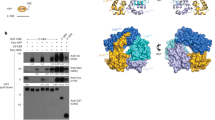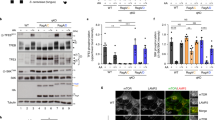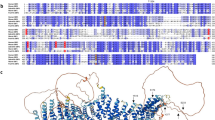Abstract
mTORC2 plays critical roles in metabolism, cell survival and actin cytoskeletal dynamics through the phosphorylation of AKT. Despite its importance to biology and medicine, it is unclear how mTORC2-mediated AKT phosphorylation is controlled. Here, we identify an unforeseen principle by which a GDP-bound form of the conserved small G protein Rho GTPase directly activates mTORC2 in AKT phosphorylation in social amoebae (Dictyostelium discoideum) cells. Using biochemical reconstitution with purified proteins, we demonstrate that Rho–GDP promotes AKT phosphorylation by assembling a supercomplex with Ras–GTP and mTORC2. This supercomplex formation is controlled by the chemoattractant-induced phosphorylation of Rho–GDP at S192 by GSK-3. Furthermore, Rho–GDP rescues defects in both mTORC2-mediated AKT phosphorylation and directed cell migration in Rho-null cells in a manner dependent on phosphorylation of S192. Thus, in contrast to the prevailing view that the GDP-bound forms of G proteins are inactive, our study reveals that mTORC2–AKT signalling is activated by Rho–GDP.
This is a preview of subscription content, access via your institution
Access options
Access Nature and 54 other Nature Portfolio journals
Get Nature+, our best-value online-access subscription
$29.99 / 30 days
cancel any time
Subscribe to this journal
Receive 12 print issues and online access
$209.00 per year
only $17.42 per issue
Buy this article
- Purchase on Springer Link
- Instant access to full article PDF
Prices may be subject to local taxes which are calculated during checkout







Similar content being viewed by others
Data availability
Mass spectrometry data have been deposited in ProteomeXchange with the primary accession code PXD014014 and provided in Supplementary Tables 1 and 2. Unprocessed images of all blots and gels are provided in Supplementary Fig. 8. The source data for all graphical representations and statistical descriptions are provided in Supplementary Table 5 for Figs. 1b,e, 2a,b,d,h, 3b,d,f,h,j, and 5b,d,f,h and Supplementary Figs. 2 and 6c. All other data supporting the findings of this study are available from the corresponding author on reasonable request.
References
Hodge, R. G. & Ridley, A. J. Regulating Rho GTPases and their regulators. Nat. Rev. Mol. Cell Biol. 17, 496–510 (2016).
Burridge, K. & Wennerberg, K. Rho and Rac take center stage. Cell 116, 167–179 (2004).
Stenmark, H. Rab GTPases as coordinators of vesicle traffic. Nat. Rev. Mol. Cell Biol. 10, 513–525 (2009).
Alberts, B. et al. Molecular Biology of the Cell 6th Edn (Garland Science, 2015).
Mayor, R. & Etienne-Manneville, S. The front and rear of collective cell migration. Nat. Rev. Mol. Cell Biol. 17, 97–109 (2016).
Weiner, O. D. Regulation of cell polarity during eukaryotic chemotaxis: the chemotactic compass. Curr. Opin. Cell Biol. 14, 196–202 (2002).
Langeberg, L. K. & Scott, J. D. Signalling scaffolds and local organization of cellular behaviour. Nat. Rev. Mol. Cell Biol. 16, 232–244 (2015).
Lemmon, M. A., Freed, D. M., Schlessinger, J. & Kiyatkin, A. The dark side of cell signaling: positive roles for negative regulators. Cell 164, 1172–1184 (2016).
Welch, C. M., Elliott, H., Danuser, G. & Hahn, K. M. Imaging the coordination of multiple signalling activities in living cells. Nat. Rev. Mol. Cell Biol. 12, 749–756 (2011).
Tang, M. et al. Disruption of PKB signaling restores polarity to cells lacking tumor suppressor PTEN. Mol. Biol. Cell 22, 437–447 (2011).
Kamimura, Y. et al. PIP3-independent activation of TorC2 and PKB at the cell’s leading edge mediates chemotaxis. Curr. Biol. 18, 1034–1043 (2008).
Artemenko, Y., Lampert, T. J. & Devreotes, P. N. Moving towards a paradigm: common mechanisms of chemotactic signaling in Dictyostelium and mammalian leukocytes. Cell. Mol. Life Sci. 71, 3711–3747 (2014).
Miao, Y. et al. Altering the threshold of an excitable signal transduction network changes cell migratory modes. Nat. Cell Biol. 19, 329–340 (2017).
Pompura, S. L. & Dominguez-Villar, M. The PI3K/AKT signaling pathway in regulatory T-cell development, stability, and function. J. Leukoc. Biol. 103, 1065–1076 (2018).
Devreotes, P. & Horwitz, A. R. Signaling networks that regulate cell migration. Cold Spring Harb. Perspect. Biol. 7, a005959 (2015).
Saxton, R. A. & Sabatini, D. M. mTOR signaling in growth, metabolism, and disease. Cell 168, 960–976 (2017).
Huang, K. & Fingar, D. C. Growing knowledge of the mTOR signaling network. Semin. Cell Dev. Biol. 36, 79–90 (2014).
Liu, L., Das, S., Losert, W. & Parent, C. A. mTORC2 regulates neutrophil chemotaxis in a cAMP- and RhoA-dependent fashion. Dev. Cell 19, 845–857 (2010).
Manning, B. D. & Toker, A. AKT/PKB signaling: navigating the network. Cell 169, 381–405 (2017).
Lien, E. C., Dibble, C. C. & Toker, A. PI3K signaling in cancer: beyond AKT. Curr. Opin. Cell Biol. 45, 62–71 (2017).
Fruman, D. A. et al. The PI3K pathway in human disease. Cell 170, 605–635 (2017).
Khanna, A. et al. The small GTPases Ras and Rap1 bind to and control TORC2 activity. Sci. Rep. 6, 25823 (2016).
Cai, H. et al. Ras-mediated activation of the TORC2–PKB pathway is critical for chemotaxis. J. Cell Biol. 190, 233–245 (2010).
Gaubitz, C., Prouteau, M., Kusmider, B. & Loewith, R. TORC2 structure and function. Trends Biochem. Sci. 41, 532–545 (2016).
Berzat, A. & Hall, A. Cellular responses to extracellular guidance cues. EMBO J. 29, 2734–2745 (2010).
Rossman, K. L., Der, C. J. & Sondek, J. GEF means go: turning on RHO GTPases with guanine nucleotide-exchange factors. Nat. Rev. Mol. Cell Biol. 6, 167–180 (2005).
Welch, H. C., Coadwell, W. J., Stephens, L. R. & Hawkins, P. T. Phosphoinositide 3-kinase-dependent activation of Rac. FEBS Lett. 546, 93–97 (2003).
Iden, S. & Collard, J. G. Crosstalk between small GTPases and polarity proteins in cell polarization. Nat. Rev. Mol. Cell Biol. 9, 846–859 (2008).
Larochelle, D. A., Vithalani, K. K. & De Lozanne, A. Role of Dictyostelium racE in cytokinesis: mutational analysis and localization studies by use of green fluorescent protein. Mol. Biol. Cell 8, 935–944 (1997).
Wang, Y., Senoo, H., Sesaki, H. & Iijima, M. Rho GTPases orient directional sensing in chemotaxis. Proc. Natl Acad. Sci. USA 110, E4723–E4732 (2013).
Senoo, H., Cai, H., Wang, Y., Sesaki, H. & Iijima, M. The novel RacE-binding protein GflB sharpens Ras activity at the leading edge of migrating cells. Mol. Biol. Cell 27, 1596–1605 (2016).
Wang, Y., Chen, C. L. & Iijima, M. Signaling mechanisms for chemotaxis. Dev. Growth Differ. 53, 495–502 (2011).
Nichols, J. M., Veltman, D. & Kay, R. R. Chemotaxis of a model organism: progress with Dictyostelium. Curr. Opin. Cell Biol. 36, 7–12 (2015).
Kortholt, A. & van Haastert, P. J. Highlighting the role of Ras and Rap during Dictyostelium chemotaxis. Cell. Signal. 20, 1415–1422 (2008).
Gerisch, G., Schroth-Diez, B., Muller-Taubenberger, A. & Ecke, M. PIP3 waves and PTEN dynamics in the emergence of cell polarity. Biophys. J. 103, 1170–1178 (2012).
Chen, M. Y., Long, Y. & Devreotes, P. N. A novel cytosolic regulator, Pianissimo, is required for chemoattractant receptor and G protein-mediated activation of the 12 transmembrane domain adenylyl cyclase in Dictyostelium. Genes Dev. 11, 3218–3231 (1997).
Shimobayashi, M. & Hall, M. N. Making new contacts: the mTOR network in metabolism and signalling crosstalk. Nat. Rev. Mol. Cell Biol. 15, 155–162 (2014).
Liao, X. H., Buggey, J. & Kimmel, A. R. Chemotactic activation of Dictyostelium AGC-family kinases AKT and PKBR1 requires separate but coordinated functions of PDK1 and TORC2. J. Cell Sci. 123, 983–992 (2010).
Kamimura, Y., Tang, M. & Devreotes, P. Assays for chemotaxis and chemoattractant-stimulated TorC2 activation and PKB substrate phosphorylation in Dictyostelium. Methods Mol. Biol. 571, 255–270 (2009).
Palomero, T. et al. Recurrent mutations in epigenetic regulators, RHOA and FYN kinase in peripheral T cell lymphomas. Nat. Genet. 46, 166–170 (2014).
Yoo, H. Y. et al. A recurrent inactivating mutation in RHOA GTPase in angioimmunoblastic T cell lymphoma. Nat. Genet. 46, 371–375 (2014).
Charest, P. G. et al. A Ras signaling complex controls the RasC-TORC2 pathway and directed cell migration. Dev. Cell 18, 737–749 (2010).
Huang, J. An in vitro assay for the kinase activity of mTOR complex 2. Methods Mol. Biol. 821, 75–86 (2012).
Sarbassov dos, D., Bulgakova, O., Bersimbaev, R. I. & Shaiken, T. Isolation of the mTOR complexes by affinity purification. Methods Mol. Biol. 821, 59–74 (2012).
Gilbert-Ross, M., Marcus, A. I. & Zhou, W. RhoA, a novel tumor suppressor or oncogene as a therapeutic target? Genes Dis. 2, 2–3 (2015).
Dopeso, H. et al. Mechanisms of inactivation of the tumour suppressor gene RHOA in colorectal cancer. Br. J. Cancer 118, 106–116 (2018).
Ambrogio, C. et al. KRAS dimerization impacts MEK inhibitor sensitivity and oncogenic activity of mutant KRAS. Cell 172, 857–868 (2018).
Jang, H., Muratcioglu, S., Gursoy, A., Keskin, O. & Nussinov, R. Membrane-associated Ras dimers are isoform-specific: K-Ras dimers differ from H-Ras dimers. Biochem. J. 473, 1719–1732 (2016).
Nan, X. et al. Ras-GTP dimers activate the mitogen-activated protein kinase (MAPK) pathway. Proc. Natl Acad. Sci. USA 112, 7996–8001 (2015).
Harwood, A. J., Plyte, S. E., Woodgett, J., Strutt, H. & Kay, R. R. Glycogen synthase kinase 3 regulates cell fate in Dictyostelium. Cell 80, 139–148 (1995).
Kim, L., Liu, J. & Kimmel, A. R. The novel tyrosine kinase ZAK1 activates GSK3 to direct cell fate specification. Cell 99, 399–408 (1999).
Kolsch, V. et al. Daydreamer, a Ras effector and GSK-3 substrate, is important for directional sensing and cell motility. Mol. Biol. Cell 24, 100–114 (2013).
Lacal Romero, J. et al. The Dictyostelium GSK3 kinase GlkA coordinates signal relay and chemotaxis in response to growth conditions. Dev. Biol. 435, 56–72 (2018).
Teo, R. et al. Glycogen synthase kinase-3 is required for efficient Dictyostelium chemotaxis. Mol. Biol. Cell 21, 2788–2796 (2010).
Lee, S. et al. TOR complex 2 integrates cell movement during chemotaxis and signal relay in Dictyostelium. Mol. Biol. Cell 16, 4572–4583 (2005).
Nakajima, A., Ishida, M., Fujimori, T., Wakamoto, Y. & Sawai, S. The microfluidic lighthouse: an omnidirectional gradient generator. Lab Chip 16, 4382–4394 (2016).
Iijima, M., Huang, Y. E., Luo, H. R., Vazquez, F. & Devreotes, P. N. Novel mechanism of PTEN regulation by its phosphatidylinositol 4,5-bisphosphate binding motif is critical for chemotaxis. J. Biol. Chem. 279, 16606–16613 (2004).
Castro, A. F., Rebhun, J. F. & Quilliam, L. A. Measuring Ras-family GTP levels in vivo–running hot and cold. Methods 37, 190–196 (2005).
Iijima, M. & Devreotes, P. Tumor suppressor PTEN mediates sensing of chemoattractant gradients. Cell 109, 599–610 (2002).
Futatsumori-Sugai, M. et al. Utilization of Arg-elution method for FLAG-tag based chromatography. Protein Expr. Purif. 67, 148–155 (2009).
Acknowledgements
We thank the members of the Iijima and Sesaki labs for their helpful discussions and technical assistance and P. Devreotes and T. Inoue for providing the plasmids and cell lines. This work was supported by grants to M.I. (NIH GM131768 and Allegheny Health Network-Sidney Kimmel Comprehensive Cancer Center), H. Senoo (Japan Society for the Promotion of Science) and H. Sesaki (NIH GM089853).
Author information
Authors and Affiliations
Contributions
H. Senoo, H. Sesaki and M.I. conceived the project and designed the study. H. Senoo and M.I. performed the experiments. R.K. assisted with the experiments. S.S., A.N. and Y.K. provided valuable reagents and equipment. H. Senoo, H. Sesaki and M.I. wrote the manuscript.
Corresponding author
Ethics declarations
Competing interests
The authors declare no competing interests.
Additional information
Publisher’s note: Springer Nature remains neutral with regard to jurisdictional claims in published maps and institutional affiliations.
Integrated supplementary information
Supplementary Figure 1 Nomenclature.
a, Rho family GTPases in Dictyostelium and human cells. b, Phylogenetic analysis of human RhoA and Rac1 against the Dictyostelium Rho family GTPases. c, Nomenclature of mTORC2 subunits in mammalian, Dictyostelium, and yeast cells.
Supplementary Figure 2 Random cell migration in WT and RacE-KO cells.
Random cell migration was recorded using a Zeiss Axio Vision inverted microscope and analysed by NIH ImageJ (n=15 cells). Values are average ± SD. Statistical analysis was performed using unpaired, two-tailed Student’s t-test.
Supplementary Figure 3 Proteomic identification of RacE binding proteins.
a and b, We identified 94 unique peptides of Tor using mass spectrometry of RacE-binding proteins (46% coverage, 200 unique spectra, 411 total spectra) in a and 10 unique of PiaA peptides (8% coverage, 18 unique spectra, 23 total spectra) in b. The sequences of the identified peptides are highlighted in yellow. Source data for identified peptides for Tor and PiaA are provided in Supplementary Table 1. Source data for all identified proteins are described in Supplementary Table 2.
Supplementary Figure 4 Detection of chemoattractant-induced phosphorylation of PKBA and PKBR1 by immunoblotting with anti-phospho-RPS6KB1 and anti-phospho-PKC-pan antibodies.
a, Amino acid sequences around hydrophobic motif undergoing phosphorylation in PKBA (T435) and PKBR1 (T470) in Dictyostelium. Conserved amino acids in AKT1 and S6K1 (RPS6KB1) in human are highlighted in blue. b, Amino acid sequences around activation loop undergoing phosphorylation in PKBA (T278) and PKBR1 (T309) in Dictyostelium. Conserved amino acids in AKT1 and PKC (PRKCs) in human are highlighted in blue. c, WT, PkbA-KO, and PkbR1-KO cells analysed by immunoblotting with anti-phospho-RPS6KB1 antibodies, anti-phospho-PKC-pan antibodies and antibodies to PKBA and PKBR1 before (0 sec) and after (30 sec) stimulation by the chemoattractant cAMP. Experiments were repeated independently two times with similar results.
Supplementary Figure 5 Comparable expression levels of different GFP–RacE proteins.
WT and RacE-KO cells expressing different RacE-constructs were analysed by immunoblotting with antibodies to GFP and actin. Experiments were repeated independently two times with similar results.
Supplementary Figure 6 Analysis of guanine nucleotide binding to RacE and RasC in response to the chemoattractant cAMP.
a-c, Differentiated Dictyostelium cells carrying GFP–RacE or FLAG–RasC were metabolically labelled using P32 for 1 hour. Cells were lysed after the chemoattractant cAMP for the indicated amounts of time. GFP–RacE and FLAG–RasC were immunopurified using GFP-Trap beads and anti-FLAG beads, respectively. Amount of purified proteins are analysed using SDS–PAGE and CBB staining in a. Bound guanine nucleotides were eluted and analysed by TLC and phosphoimaging in b. Quantification of GTP and GDP signals is shown in c (n=3 independent experiments). Values are the average ± SD.
Supplementary Figure 7 Purification of mTORC2, Tor, RacE, and RasC/G.
a, Immunobloting shows endogenous PiaA was co-purified with FLAG–Tor under CHAPS-containing, low-salt conditions. Untransfected cells were negative controls. b, Anti-FLAG beads carrying FLAG–Tor immunopurified under CHAPS-containing, low-salt conditions were rinsed with 0.5 M NaCl (high-salt) wash after which PiaA dissociated from FLAG–Tor. c, Lst8, detected by mass spectrometry, was also dissociated from FLAG–Tor after the high-salt wash. 18 unique peptides of Lst8 were identified (82% coverage, 44 unique spectra, 86 total spectra), sequences highlighted in yellow. d, PiaA is normally expressed in Rip3-KO cells. WT and Rip3-KO cells were analysed using anti-PiaA antibodies. e and f, The indicated purified proteins were analysed using SDS–PAGE followed by CBB staining. FLAG–Tor, FLAG–RacE proteins, FLAG–RasC/G proteins, FLAG–Lst8, and FLAG–PiaA are indicated (*). Degradation products of FLAG-RasG proteins were observed, detected by anti-FLAG antibodies. Experiments were repeated independently two times with similar results in a, b and d-f.
Supplementary Figure 8
Unprocessed images of all gels and blots.
Supplementary information
Supplementary Information
Supplementary Figures 1–8 and Supplementary Table titles/legends
Supplementary Table 1
Identified peptides for Tor and PiaA.
Supplementary Table 2
Identified RacE-binding proteins.
Supplementary Table 3
List of plasmids used.
Supplementary Table 4
List of antibodies used.
Supplementary Table 5
Statistics source data.
Rights and permissions
About this article
Cite this article
Senoo, H., Kamimura, Y., Kimura, R. et al. Phosphorylated Rho–GDP directly activates mTORC2 kinase towards AKT through dimerization with Ras–GTP to regulate cell migration. Nat Cell Biol 21, 867–878 (2019). https://doi.org/10.1038/s41556-019-0348-8
Received:
Accepted:
Published:
Issue Date:
DOI: https://doi.org/10.1038/s41556-019-0348-8



